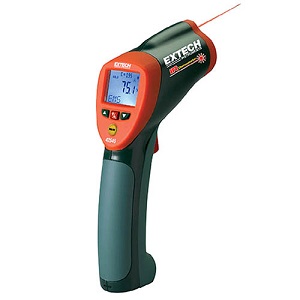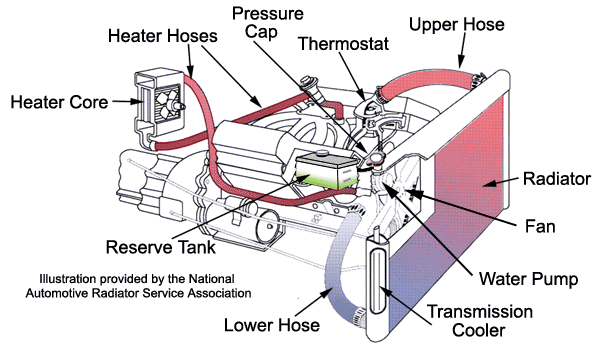excellent question,
lets look at a few points
the part your looking at serves two major functions, it forces all air to surface in the aux fluid tank where its not lowering the radiator efficiency, and it add both a slight increase in surface area that allows air to absorb heat from the coolant, and slightly more coolant,, and maintains the full surface area of the radiator, to use to transfer heat , its possibly curing the symptom not the problem,and while in some cases that helps its basically a band aid approach,
finding the source of the heat will generally allow you to figure out a way to reduce the heat,if you can reduce the heat theres a lower load on the cooling system.
the first rather obvious source is the engine tune, if your ignition timing or your fuel/air ratio is off the ideal ranges heat increases, generally youll want the fuel/air ratio to be between about 12.7:1 and 14:1 for decent power production, and anything leaner than 14.7:1 generally increases heat, in the exhaust, mild detonation increases engine heat quickly, vacuum leaks tend to increase engine heat.
reading the spark plugs and use of an INFRARED TEMP GUN for tuning helps, it allows you to isolate the hotter areas and get a good idea as to the source, of problems. In most cases it also allows you to track the heat as its routed thru the cooling system and spot restrictions,
any restriction of coolant flow such as a restrictive T-stat,restrictive hoses, or less than efficient water pump will reduce the cooling systems potential, so check out those issues.
viewtopic.php?f=4&t=1337&p=2921&hilit=+infrared#p2921
ok first the HEAT generated is the direct result of BOTH the amount of fuel/air burnt PER minute and the engines internal FRICTION, both contribute a significant amount of heat.
cooling is the process of EFFICIENTLY TRANSFERRING the engine heat, produced by friction, from the OIL, that absorbs the heat and that transports the heat from the valve train, rotating assembly and bearings to the block, and from the block to the coolant where, that heat dissipated to the air flowing thru the radiator, from its surface fins & tubes where its again transferred to the air, and dispersed.
MORE INFO
viewtopic.php?f=57&t=853
viewtopic.php?f=54&t=2187
viewtopic.php?f=57&t=176
viewtopic.php?f=57&t=4230
to reduce heat theres several routes you can go,
you can reduce friction thru the use of the better synthetic oils
you can speed the heat transfer rates thru the use of thinner viscosity oil that flows thru the clearances faster
you can add a large oil cooler with a electric fan , and a baffled high capacity oil pan,as the combo will dissipate heat directly to the air ,lower the heat loads transferee to the coolant and radiator.
you can increase the size of the radiator, or its surface area thru use of larger tubes and more fins.
you can increase the air flowing thru it with larger fans or more efficient duct work
you can change the coolant type, or composition, and use additives like water wetter that increases the heat transfer rates by lowering surface tension, and you can add a high volume water pump.
CURES
as a general rule if the engines tuned correctly, and has the correct clearances and theres no mechanical issues, (you'll want to verify that carefully)
Obviously the cure is to have your system set up so the coolant in the radiator and the oil in the engine dissipate heat to the outside air at a far faster rate than the engine can add heat to those fluids
Generally the larger the surface area of the radiator and the higher is fluid capacity, the longer the coolant flowing thru it has to transfer heat, to the outside air, the larger the fans flow capacity and the tighter and more effective the duct work is around the fan, or fans the more air can be forced thru the radiator fins to absorb heat. id point out that a pusher fan in front and a puller fan behind the radiator will usually help, and a fairly cheap source of pusher electric fans is salvage yards(fords like taurus use them alot)
youll want to either add a large efficient oil cooler with a powered fan, and try to maintain, your oil temps at a steady 215F-220F range(as oil does far more of the actual engine cooling than most people will ever believe)
or add EITHER or BOTH a larger radiator or use more effective duct work and fans to force far more air over the radiator fins, to aid heat transfer rates
viewtopic.php?f=57&t=755
in a few cases a T-stat is restricting flow, and simple mods tend to have amazing results, since its free and easily done IVE always suggested drilling 6-8 1/8" holes in the T-stat flange area and in some cases it has produced remarkable reductions in average coolant temp ranges
viewtopic.php?f=57&t=348
BTW one frequently overlooked factor is your alternator size,in amps and wiring the alternator correctly, if your running a 70amp-100 amp stock alternator and using electric fans to cool the engine,its not going to provide the power required to spin the fans nearly fast enough to cool the engine like a better 200 amp alternator can
cooling is basically the process of transferring heat efficiently from its source, to the outside air flow as rapidly as possible thru the process of oil and coolant flow absorbing and transporting the heat from the hotter components to the, outside air, the faster, and more efficiently the fluids can absorb, transfer and release that heat, and the greater the surface area, and conductivity between the hot fluids, and the larger the volume of those fluids, in the heat exchange areas and the higher the speeds of the outside airflow the more likely you'll be to reduce the heat generated in the hotter areas, increasing the volume of oil and coolant in the system helps, increasing the surface area of the radiator, or adding an oil cooler or transmission cooler that adds an additional heat transfer surface to bleed off that heat to the outside air or allow the oil to release heat thru other surfaces than the radiators trans fluid cooler section will help, as will, adding a larger capacity oil pan and oil cooler, simply because the oil does much of the heat transfer from the hottest components to the coolant, so anything you can do to reduce oil temperatures tends to help. oil in the oil pan is exposed to air flowing over the oil pans outer surface and that will generally reduce its temperature, so the larger the oil pan capacity the longer the oil tends to be exposed to that cooling effect, naturally a real oil cooler with an electric fan will work even better but you can use both in tandum
COMMENTS? QUESTIONS?














